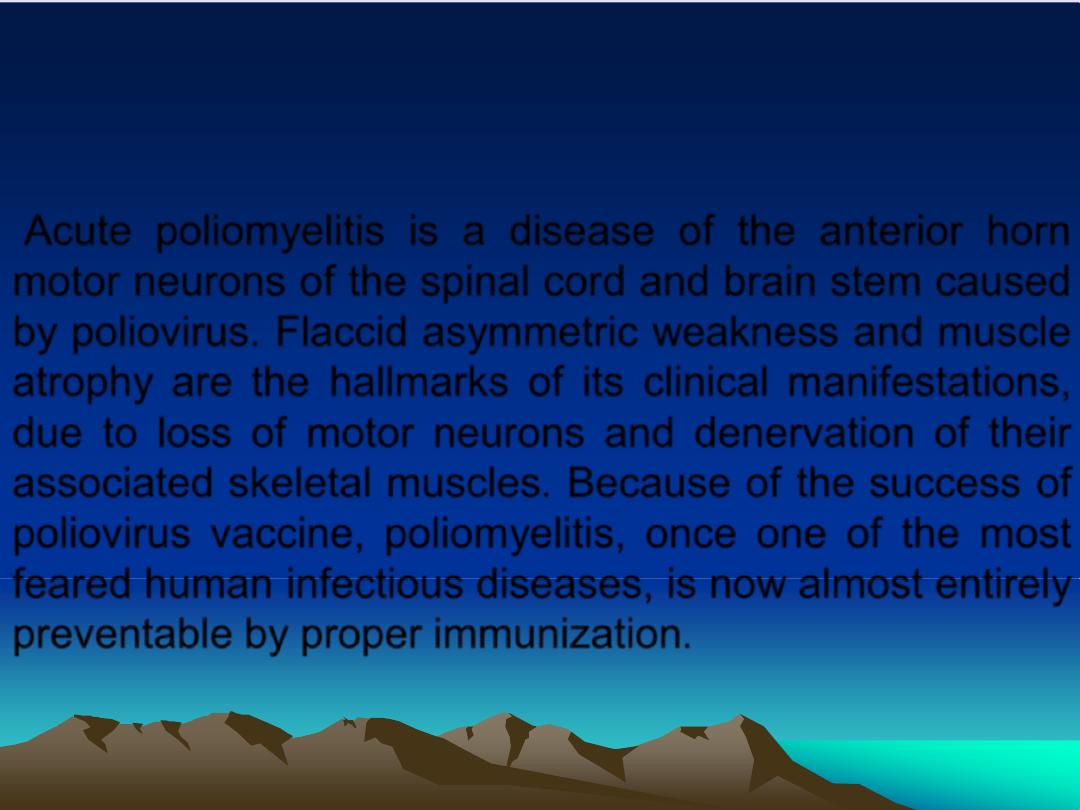
Acute Poliomyelitis

Lecturer:
Assistant Prof.
Dr. Emad Maaroof Al Hadeethi
TUCOM

Acute poliomyelitis is a disease of the anterior horn
motor neurons of the spinal cord and brain stem caused
by poliovirus. Flaccid asymmetric weakness and muscle
atrophy are the hallmarks of its clinical manifestations,
due to loss of motor neurons and denervation of their
associated skeletal muscles. Because of the success of
poliovirus vaccine, poliomyelitis, once one of the most
feared human infectious diseases, is now almost entirely
preventable by proper immunization.

In
1988,
the
World
Health
Organization
initiated the Global Polio Eradication Initiative to
eradicate poliomyelitis; at the time, it was
endemic in 125 countries. As of 2006, only 6
countries are endemic for polio; however, the
worldwide
campaign
to
eradicate
polio
continues today, as do efforts to prevent
transmission of the disease into polio-free
areas.

Pathophysiology
Acute poliomyelitis is caused by small ribonucleic
acid (RNA) viruses of the enterovirus group of the
picornavirus family. The single-stranded RNA core is
surrounded by a protein capsid without a lipid
envelope, which makes poliovirus resistant to lipid
solvents and stable at low pH. Three antigenically
distinct strains are known, with type I accounting for
85% of cases of paralytic illnesses. Infection with one
type does not protect from the other types; however,
immunity to each of the 3 strains is lifelong.

The enteroviruses of poliomyelitis infect the
human intestinal tract mainly through the fecal-
oral route (hand to mouth). The viruses multiply
in oropharyngeal and lower gastrointestinal
tract mucosa during the first 1-3 weeks of the
incubation period. Virus may be secreted in
saliva and feces during this period, causing
most host-to-host transmission.

After the initial alimentary phase, the virus
drains into the cervical and mesenteric lymph
nodes and then into the blood stream. Only 5%
of infected patients have selective nervous
system involvement after viremia. It is believed
that replication in extraneural sites maintains
the viremia and increases the likelihood that the
virus will enter the nervous system.

The poliovirus enters the nervous system by
either crossing the blood-brain barrier or by
axonal transportation from a peripheral nerve. It
can cause nervous system infection by
involving the precentral gyrus, thalamus,
hypothalamus, motor nuclei of the brainstem
and surrounding reticular formation, vestibular
and cerebellar nuclei, and neurons of the
anterior and intermediate columns of the spinal
cord.

The nerve cells undergo central chromatolysis (
dissolution of the Nissl bodies in the cell body of a
neuron ) along with an inflammatory reaction.
As the chromatolysis process goes on further, muscle
paralysis or even atrophy appears. Gliosis ( non
specific reactive changes in glial cells in response to
damage to CNS involving proliferation and
hypertrophy of several different types of glial cells
including astrocytes, microglia and oligodendrocytes )
develops when the inflammatory infiltrate has
subsided, but most surviving neurons show full
recovery.

Frequency
Acute poliomyelitis has a worldwide distribution with the peak
season in the months of July to September with concentration
in tropical areas of the Northern Hemisphere.
Six countries are endemic to polio: Afghanistan, Egypt, India,
Niger, Nigeria, and Pakistan.
Acute poliomyelitis has no racial predilection and male-to-
female ratio is 1:1.
Poor sanitation and crowded circumstances are 2 additional
factors associated with dissemination.

Mortality and Morbidity
4-8% show only nonspecific illness, and 1-2% of
infections finally result in neurologic symptoms.
The incidence of paralytic diseases increases with
young age, advanced age, recent hard exercise,
tonsillectomy, pregnancy, and impairment of B-
lymphocyte defenses.
The mortality from acute paralytic poliomyelitis is 5-
10%, but it can reach 20-60% in cases of bulbar
involvement.

Clinical Manifestations
Most patients (95%) with poliomyelitis virus
infections are asymptomatic or have only mild
systemic symptoms, such as pharyngitis or
gastroenteritis.
These cases are referred to as minor illness or
abortive poliomyelitis. The mild symptoms are related
to
viremia and immune response
against
dissemination of the virus. Only 5% of patients exhibit
different severities of nervous system involvement,
from nonparalytic poliomyelitis to the most severe form
of paralytic poliomyelitis.

The prodromal symptoms include headache, fever of 38-40
°C,
sore throat, anorexia, nausea, vomiting, and muscle aches.
These symptoms may or may not subside in 1-2 weeks.
Headache and fever, as well as signs and symptoms of
nervous system involvement (eg, irritability, restlessness,
emotional instability, and signs of meningeal irritation may
follow.
Preparalytic symptoms also may develop into paralytic ones

Paralytic poliomyelitis
The incubation period from virus exposure to the neurologic
phase can last 4-10 days but may extend to 4-5 weeks.
Severe muscle pain, spasms, and then weakness develop.
Muscle weakness tends to become maximal within 48 hours
but may develop for longer than a week. Weakness is
asymmetric with the lower limbs affected more than upper
limbs.
Muscle tone is flaccid, and the reflexes initially are brisk but
then become absent.
Coarse fasciculations also are observed frequently in patients
with paralytic poliomyelitis.
Patients also complain of paresthesias in the affected limbs
without real sensation loss.

Paralysis remains for days or weeks before slow recovery
occurs over months or years.
Factors favor development of paralytic disease remains
unclear, but some evidence exists that physical activity and
intramuscular injections during the prodrome may be important
exacerbating factors.
The purely bulbar form of poliomyelitis without limb weakness
may occur in children, particularly in those whose tonsils and
adenoids have been removed.
Bulbar paralysis with spinal involvement is more common in
adults, most frequently involving the medulla leading to
dysphagia, dysphonia, respiratory failure, and vasomotor
disturbance.
When paralysis of diaphragmatic and intercostal musculature
also occurs, patients need immediate respiratory assistance and
intensive care because of life-threatening respiratory failure.

Cranial nerve and bulbar involvement can cause respiratory
obstruction, due to
decreased respiratory drive (mucus
plugging)
or
actual pharyngeal weakness
(when the ninth
(
and tenth cranial nerve nuclei are involved
The encephalitic form of poliomyelitis is very rare and
manifests as agitation, confusion, stupor, and coma.
Autonomic dysfunction is common, and it has a high
mortality.
Vital signs are the key to monitoring patients with
poliovirus infection.
Muscle weakness can be assessed by muscle strength
testing (power).
Usually asymmetric proximal weakness is present with
more involvement of lumbar than cervical segments.
Atrophy of muscle may be detected 3 weeks after onset of
paralysis, which becomes maximal at 12-15 weeks and
remains permanent.

Differential diagnosis:
Acute meningitis
Other motor polyneuropathies
Acute intermittent porphyria
Acute transverse myelitis
Acute encephalitis caused by coxsackie virus and
echoviruses
Other enteroviruses (coxsackie)
HIV neuropathy
Botulism

Laboratory Studies:
-
Cerebrospinal fluid (CSF) examination:
Pressure may be increased. Pleocytosis (neutrophils in the
first few days, then lymphocytes). The CSF protein content
may be elevated slightly with a normal glucose, except in
patients with severe paralysis, who may demonstrate
protein elevations to 100-300 mg/dL for several weeks.
- CBC count (leukocytosis may be present).
- Identification of virus from throat washing, stool culture, blood
culture, and CSF culture.
- Virus antibody titer (4-fold rise)
- Polymerase chain reaction.
Imaging Studies
MRI may show localization of inflammation to the spinal cord
anterior horns.
Electromyography
also useful in diagnosis
.

Treatment
only supportive
Rehabilitation Program
Physical Therapy
Physical therapy plays an important role in rehabilitation for
patients with poliomyelitis.
- Patients with muscle paralysis benefit from frequent passive
range of motion (PROM) and splinting of joints to prevent
contractures.
- Chest physical therapy also helps patients with bulbar
involvement to prevent any pulmonary complications such as
atelectasis.
- Frequent repositioning of the paralyzed patients helps prevent
bedsores
.

Prevention
Prevention has been proven to be the key to treatment for
poliomyelitis. Development of effective vaccines represent
significant achievements. As a result of the introduction of
inactivated poliovirus vaccine in the 1950s ( contain the 3
serotypes of poliovirus), followed by oral poliovirus vaccine (live
attenuated virus; contain type I and type III poliovirus
serotypes) in the 1960s, cases of poliomyelitis in the United
States have become rare following vaccination.
Inadequate use of the vaccine in areas with low standards for
public health still may increase the risk of outbreaks of
poliomyelitis because of lack of immunity.

Complications
- Urinary tract infection usually is transient during
acute phase poliomyelitis.
- Other complications (eg, atelectasis,
pneumonia, pulmonary edema, myocarditis)
also may occur.
- Respiratory failure may be the result of
respiratory muscle paralysis or airway
obstruction.

Prognosis
The overall prognosis for patients with poliomyelitis is good. Only
5-10% mortality (slightly higher in pediatric and elderly
populations) results from acute paralytic poliomyelitis because
of respiratory and cardiovascular impairments.
Most patients recover from respiratory failure, and only a small
percentage of patients need chronic respirator care.

THANK YOU
